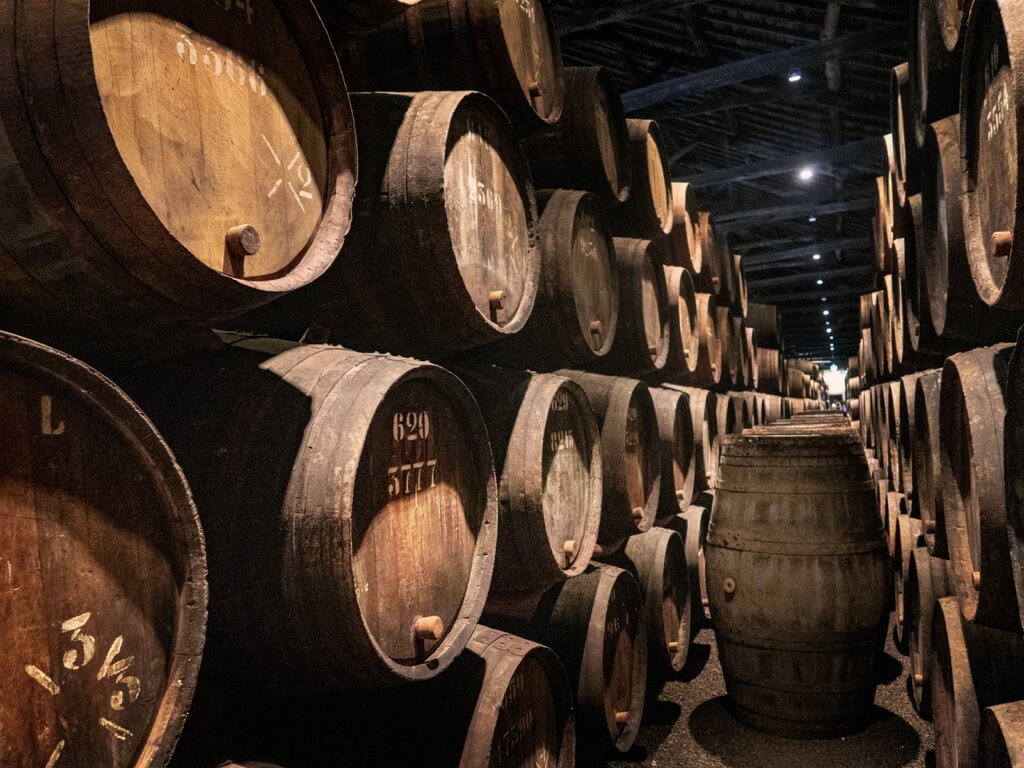Factors Influencing Whisky Aging
- Time’s Influence: Time is the cornerstone of whisky aging. The distinction between a 30-year-old whisky and its 3-year-old counterpart is unmistakable. Yet, superiority isn’t inherently tied to age. Quality casks expedite maturation, but the duration spent resting in storage remains crucial.
- Barrel Size Dynamics: The size of the cask is akin to a temporal machine. Smaller casks accelerate aging due to their larger surface area. Devoting three decades to a smaller cask might overwhelm the whisky with excessive wood influence after evaporation.
- Unveiling Barrel Character: The essence lies in the barrel’s composition and its past. The wood type, its history, and the remnants of previous contents all contribute to the final product’s profile.
While US distilleries primarily employ virgin American oak barrels for bourbon aging, Scotch tradition veers toward barrels that previously cradled other spirits like sherry and bourbon.
American barrels, replete with life post-bourbon, find a new purpose across the Atlantic. Sherry, too, plays a part in this saga, arriving in the UK and ultimately offering its emptied casks for whisky. These vessels not only provide a cost-effective storage solution but also impart enriched flavors to the liquid gold within.
Whisky Cask Types and Origins
| Cask Type | Origin |
|---|---|
| Apera | Australia |
| Beer (including Stout and IPA) | United Kingdom |
| Bourbon | Kentucky, USA |
| Bordeaux | Bordeaux, France |
| Calvados | Normandy, France |
| Cognac | France |
| Islay whisky | Islay, Scotland |
| Madeira | Madeira, Portugal |
| Maple | Canada |
| Marsala | Italy |
| Mizunara | Japan |
| Plum liquor | Japan |
| Port | Portugal |
| Red wine | France, California, Portugal |
| Rum | Caribbean |
| Rye whiskey | USA |
| Sauternes | France |
| Sherry (including Oloroso and PX) | Spain |
| Tokaji | Hungary |
| Tuscan wine | Italy |
Which Brands Use These Casks
Apera Casks (Australia)
- Used By: Some Australian distilleries like Starward Whisky
Apera casks, similar to Sherry casks, offer rich and fruity notes due to their previous use for aging fortified wine. Starward utilizes these casks to infuse their whiskies with bold flavors, adding depth and complexity.
Beer Casks (including Stout and IPA) (UK)
- Used By: BrewDog Distillery, Glenfiddich
BrewDog, known for its craft beers, repurposes its beer casks (Stout and IPA) to age whisky. Glenfiddich experimented with IPA casks, infusing their whisky with unique hoppy and citrusy notes for a distinctive profile. - Glenfiddich is known for innovation, experimenting with various cask finishes to create unique expressions. Their Experimental Series showcases whiskies finished in different casks, like rum or IPA beer, adding layers of flavors and appealing to diverse palates.
Bourbon Casks (Kentucky, USA)
- Used By: Almost all Scotch whisky producers and various others worldwide
Bourbon casks, made of charred American oak, are the most common in whisky aging. They impart sweet vanilla, caramel, and oak flavors. Many brands, like Glenfiddich and Macallan, rely on these for their core expressions.
Bordeaux Casks (Bordeaux, France)
- Used By: Glenmorangie
Bordeaux casks offer red fruit and wine-like characteristics. Glenmorangie occasionally finishes some of their whiskies in these casks, resulting in a marriage of whisky sweetness with the Bordeaux’s winey nuances.
Calvados Casks (Normandy, France)
- Used By: A few smaller distilleries for limited edition releases
Calvados casks contribute to apple and pear notes. Distilleries sometimes opt for these casks for special releases, adding a distinct fruitiness to their whiskies.
Cognac Casks (France)
- Used By: A few high-end whisky producers for exclusive releases
Cognac casks impart rich, dried fruit and floral aromas. They are occasionally chosen for exclusive releases to create luxurious and complex whisky profiles.
Madeira Casks (Madeira, Portugal)
- Used By: Balvenie
Madeira casks infuse whisky with rich, nutty, and fruity notes, complementing Balvenie’s sweet and honeyed character with additional complexity. - Balvenie explores the nuances of different casks, incorporating Madeira and rum casks into their aging process. Madeira casks infuse nutty and fruity notes, while rum casks add tropical sweetness, contributing to Balvenie’s complexity and character.
Maple Casks (Canada)
- Used By: A few experimental craft distilleries
Maple casks bring subtle sweet maple syrup hints to whisky, experimented with by some smaller distilleries to add unique sweetness.
Marsala Casks (Italy)
- Used By: Few independent bottlers
Marsala casks impart wine-like sweetness, enhancing whisky with a range of fruity and nutty flavors for limited edition releases.
Mizunara Casks (Japan)
- Used By: Japanese distilleries like Yamazaki and Hakushu
Mizunara oak offers exotic spices, sandalwood, and incense notes, contributing to the complexity of Japanese whiskies, and creating unique profiles. - Suntory’s Yamazaki uses Mizunara oak, a rare and indigenous Japanese oak, for its distinctive flavors. Mizunara imparts sandalwood, spice, and incense notes, enhancing Yamazaki’s complexity and contributing to its revered status.
Plum Liquor Casks (Japan)
- Used By: Experimental smaller Japanese distilleries
Plum liquor casks add a subtle fruitiness, experimented with by smaller distilleries for limited edition releases for nuanced flavors.
Port Casks (Portugal)
- Used By: Glenmorangie, Glenfiddich
Port casks lend rich, berry-like sweetness. Glenmorangie and Glenfiddich finish some expressions in these casks, creating a fusion of whisky richness and port wine sweetness. - Glenmorangie often employs port and wine casks to finish their whiskies, elevating them with fruity and wine-like sweetness. This approach creates whiskies with intricate flavors, blending their signature smoothness with nuanced undertones.
Red Wine Casks (France, California, Portugal)
- Used By: Edradour, BenRiach
Red wine casks offer a variety of flavors from different regions—fruity notes, tannins, and sometimes spice-enhancing whisky profiles for distinct limited releases.
Rum Casks (Caribbean)
- Used By: Balvenie, Glenfiddich, Glenlivet
Rum casks impart tropical fruit, caramel, and spice notes. These casks are used for finishing or maturing whisky, contributing to a rich and sweet profile. - Glenlivet has explored rum cask finishes, infusing their whiskies with tropical fruit and sweet spice. This experimentation creates a unique flavor profile, appealing to whisky enthusiasts seeking something different.
Rye Whiskey Casks (USA)
- Used By: Few American distilleries and experimental Scotch distilleries
Rye whiskey casks add spicy and peppery notes. Some Scotch distilleries experiment with these casks for unique flavor profiles.
Sauternes Casks (France)
- Used By: A few limited edition releases by various distilleries
Sauternes casks provide sweet honeyed flavors with a touch of acidity. Distilleries occasionally finish whisky in these casks for distinctive releases.
Sherry Casks (including Oloroso and PX) (Spain)
- Used By: Macallan, GlenDronach, Aberlour
Sherry casks are iconic for imparting rich dried fruit, nutty sweetness, and depth. These casks are extensively used, especially in sherried whiskies. - Macallan’s dedication to sherry casks is iconic. They meticulously select Spanish oak casks seasoned with sherry, allowing the whisky to absorb rich dried fruit, spice, and oak influences. This commitment defines their distinctively rich and complex flavor profile.
- Aberlour relies on sherry casks for their whiskies, embracing the rich, sherried character that defines their expressions. The sherry influence contributes to the depth, sweetness, and dried fruit notes in their whiskies.
Tokaji Casks (Hungary)
- Used By: Few independent bottlers
Tokaji casks add honeyed sweetness and subtle fruity notes, experimented with by some distilleries for unique limited editions.
Tuscan Wine Casks (Italy)
- Used By: Few independent bottlers
Tuscan wine casks bring nuanced flavors of red fruits and herbs, occasionally used for limited edition whisky releases for added complexity.
The essence of top whisky brands lies in their artful cask selection, where each barrel becomes a canvas for flavor creation. From Macallan’s dedication to sherry-infused richness to Glenfiddich’s exploratory foray into diverse cask finishes, the significance of casks extends beyond storage—it’s a narrative of innovation. These distilleries meticulously weave flavors from Madeira, port, rum, and even rare Mizunara oak, each cask contributing its unique essence to the liquid gold.

